A recent analysis by the New York Times describes how the US national response to COVID started off pretty uniformly. By mid-2020, government lockdowns, school closings, and masking requirements were happening across the country and across party lines, all following the recommendations of the best available science. There was considerable dissent, as we recall. From President Trump down through conservative media outlets, there was no love lost on masking and school closing policies, but the official COVID policies adopted by states were generally aligned with recommendations from the Centers for Disease Control (CDC).
Until 2021. As pressure from the right started building over how “miguided” health bureaucrats were infringing on our “freedom,” and as anti-Fauci mania hit a fevered pitch, state policies began diverging. States like Texas and Florida backed away from the COVID fight almost entirely.
At the same time, in the spring and summer of 2021, the Delta wave of COVID began tearing through states with relatively low vaccination coverage. Florida’s vaccination rate had been hovering at just below the national average in 2020, but dropped precipitously in 2021, especially among the young. According to a study published in the Lancet in October of 2021, this drop resulted in an additional 664,000 COVID cases in Florida, including 61,000 additional hospitalizations and more than 16,000 additional deaths.
What happened? The evidence was abundantly clear even then that vaccines saved lives. The chart below shows the relationship between vaccination rates and deaths between January 0f 2020 and May of 2023.
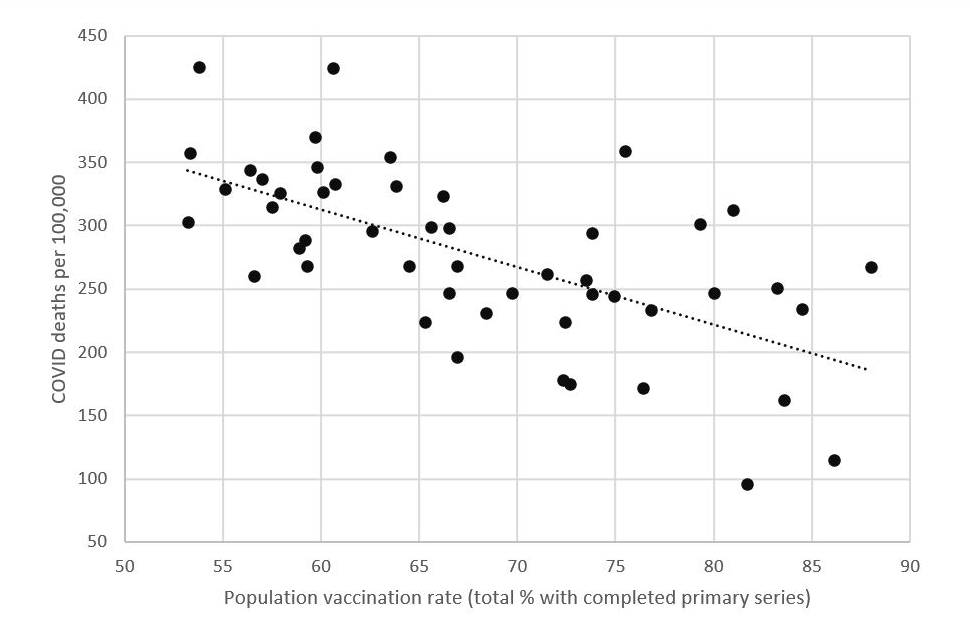
As it turns out, this shift had everything to do with politics and nothing to do with evidence. Conservative activists in Florida were increasingly unhappy about COVID restrictions, so governor Ron DeSantis relented and started looking for excuses to scale these restrictions back. Previously, DeSantis hadn’t arrived at any of his COVID policy decisions through ignorance or acquiescence. By all accounts, the governor was well versed in the science of the pandemic. And in 2020, Florida’s vaccination rates were above the national average and deaths from COVID were below average.
But with his political base revolting, and maybe to give some pseudoscientific cover to his policy retreat, the governor started taking his COVID advice from neuroradiologist Scott Atlas in 2021 instead of from the CDC (see our previous essays about elevating non-experts like Atlas to positions of authority). Atlas, along with a number of other COVID quacks who were given ample media exposure by conservative outlets like Fox, advocated herd immunity as the best defense against COVID, especially for younger Floridians.
Thousands died as a result of the governor’s new pseudoscience policy, and yet DeSantis argues that Florida “got it right” because he was willing to stand up for the rights of individuals. On the campaign trail, DeSantis says more liberal states traded away these freedoms while Florida preserved jobs, in-person schooling and quality of life. Some of this is true. Many other states, not just Florida, also traded additional “freedom” for additional deaths during the pandemic. But at the cost of 16,000 lives in Florida alone?
Was Florida the only killing field during this period? Understanding how each state was affected by the COVID crisis means looking at all the variables that affected each state, such as access to health care and vaccinations, the average age and medical condition of state residents, the resilience of the state’s health care system, how many people lost their jobs, and more. Lots of analysis has already come out on this topic; Politico published a very readable summary report in late 2021 (see the link in the additional reading section). In this report and others, there is lots of phrasing like “Republican-led states tended to be more resistant to mask mandates” and “Republican governors…experienced worse health outcomes.” But what do the actual numbers look like? How many other states adopted COVID policies that may have led to excess deaths, and how many deaths are we talking about here?
To help get a better handle on this, the following charts plot the deaths and vaccination data from the above chart against the conservative composition of state legislatures in 2021 as measured by the American Conservative Union (ACU). This compostion varies slightly from year to year; the charts below and elsewhere in this essay use ACU figures from 2021.
As it turns out, the correlations between the conservative composition of state legislatures and both the COVID vaccination rate and COVID death rate are quite strong (0.86 for vaccinations, 0.52 for deaths). In the following charts, Republican-majority legislatures are indicated in red, Democrat-majority legislatures in blue.
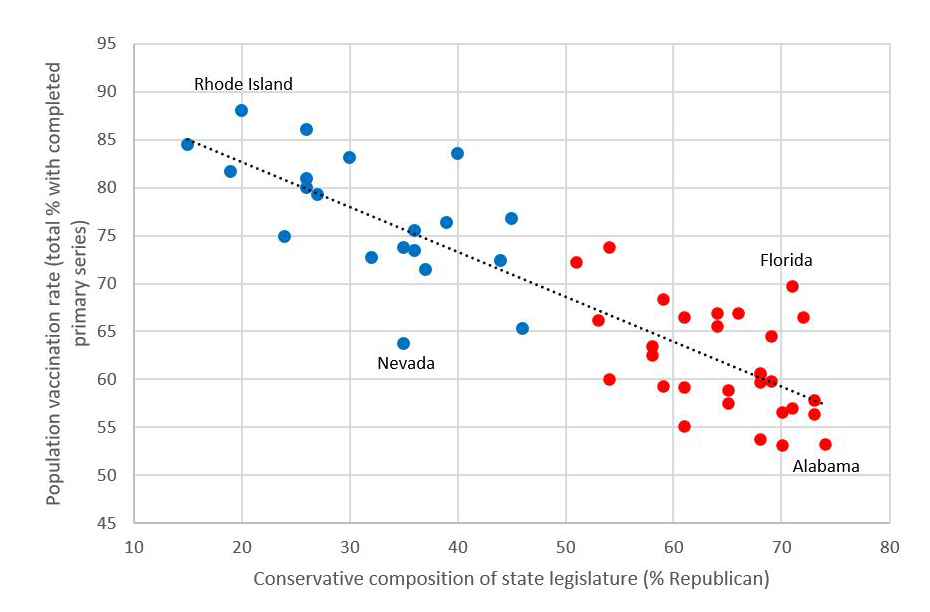
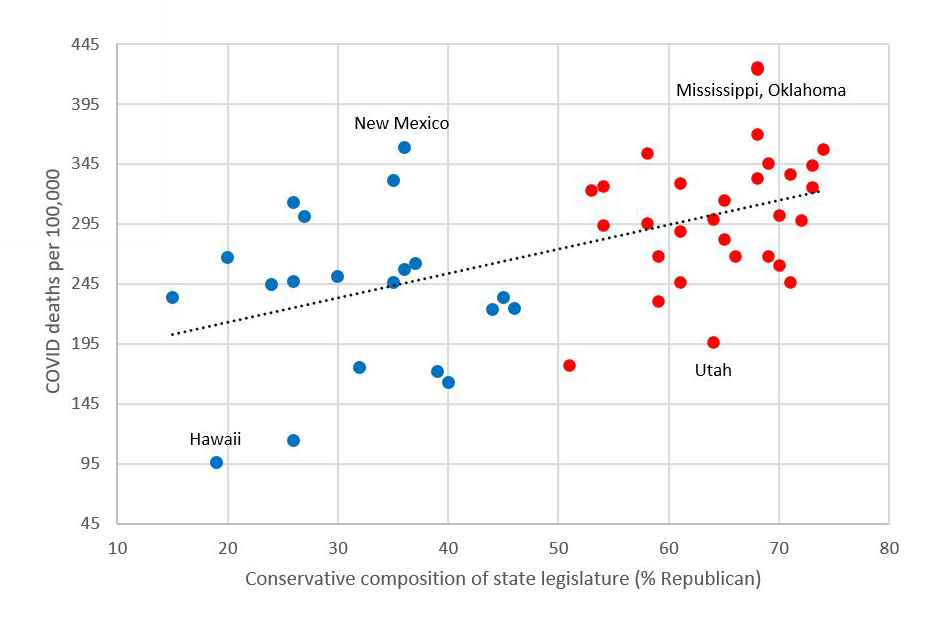 Mind you, these correlations don’t mean that conservative-led legislatures caused hundreds of thousands of additional deaths throughout the US between 2020 and 2023—there are many other factors to consider here, as mentioned. But clearly, the population of conservative states wasn’t vaccinated at the same rate as the population of liberal states, for whatever reason, and a much higher percentage of people died in these states as a result, for whatever reason. Tragically, political grandstanding looks like a plausible explanation in Florida, where the dots are easy to connect between policies that made the state more vulnerable to the Delta wave, and more deaths that occurred as a result of this vulnerability.
Mind you, these correlations don’t mean that conservative-led legislatures caused hundreds of thousands of additional deaths throughout the US between 2020 and 2023—there are many other factors to consider here, as mentioned. But clearly, the population of conservative states wasn’t vaccinated at the same rate as the population of liberal states, for whatever reason, and a much higher percentage of people died in these states as a result, for whatever reason. Tragically, political grandstanding looks like a plausible explanation in Florida, where the dots are easy to connect between policies that made the state more vulnerable to the Delta wave, and more deaths that occurred as a result of this vulnerability.
Is COVID an isolated example of how politicians can put politics over evidence? Before I answer this question, I first want to apologize for picking on conservatives in this essay. A fair and balanced answer would highlight examples from both sides of the political spectrum. But honestly, examples of conservatives putting politics over evidence are just a whole lot easier to find in our current political climate, so I’m going to be lazy here and just stick with criticizing conservative politics for the sake of argument, acknowledging that I may indeed be ignoring some juicy liberal state faux pas (which I would be happy to highlight in a future essay).
But to the question again, are there other examples of politicians putting politics over evidence? Yes, of course—far too many to list in this blog post. But to pick the low hanging fruit, climate change is probably the poster child of this dynamic. Around the country today, insurance companies are either increasing their rates, scaling back coverage, or entirely pulling out many areas of the country as climate catastrophes grow more severe and frequent. Coastal areas of the US are particularly vulnerable. One might think that by now, climate change awareness should be kind of a no brainer. It obviously isn’t, but can we quantify these attitudes by state, and see what kinds of reality vs. politics challenges are ahead? Sort of.
In a 2020 study by Johns Hopkins University and the Trust for America’s Health, researchers ranked how vulnerable states were to climate change—how much climate change would affect environmental measurables like extreme heat, flooding, drought, wildfires and storms. They also calculated potential social and demographic impacts using measurables like poverty, income inequality, disability, housing, and education. The study also measured the preparedness of each state to deal with these crises, based on factors like the state’s ability to track health threats, and the strength of the state’s community planning and coordination networks, health care delivery systems, and environmental monitoring offices.
As the charts below show, states with the highest levels of vulnerability—predominantly located in the Southeast US—also tended to be among the least prepared. The political dimension of this relationship is that these same states are mostly run by conservative legislatures, and conservatives are more likely, on average, to dismiss climate change as a threat. The latest polling data from Pew shows that only one in five Republicans think climate change poses a threat to our well-being (compared to 78% of Democrats), and only one in eight Republicans considers climate change to be a top priority. If conservative legislatures are indeed facing more of a challenge when it comes to climate change threats and preparedness than their liberal state counterparts, will they be up to the task? Is evidence going to win out over politics in time to make a difference?
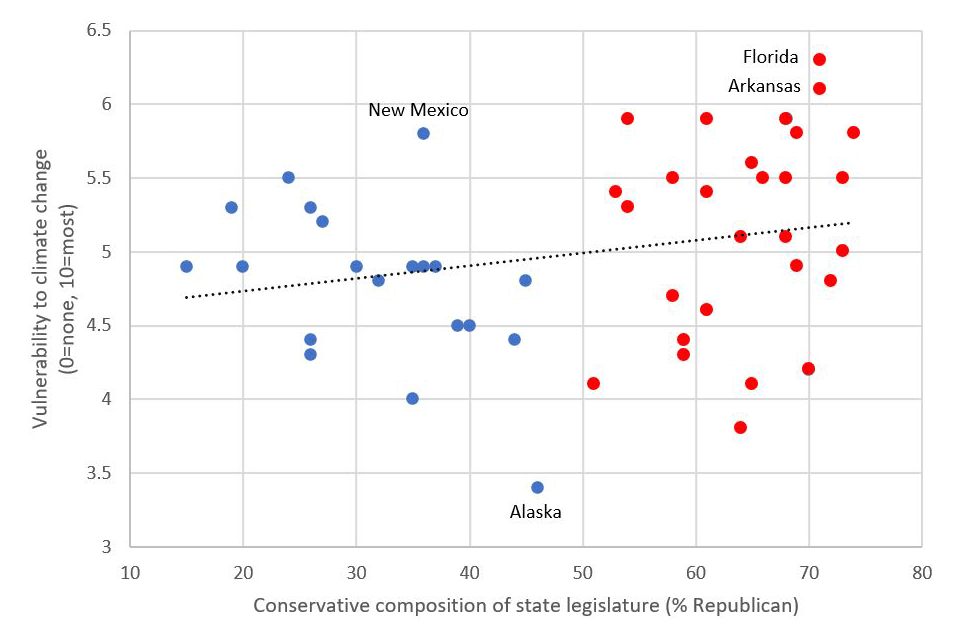
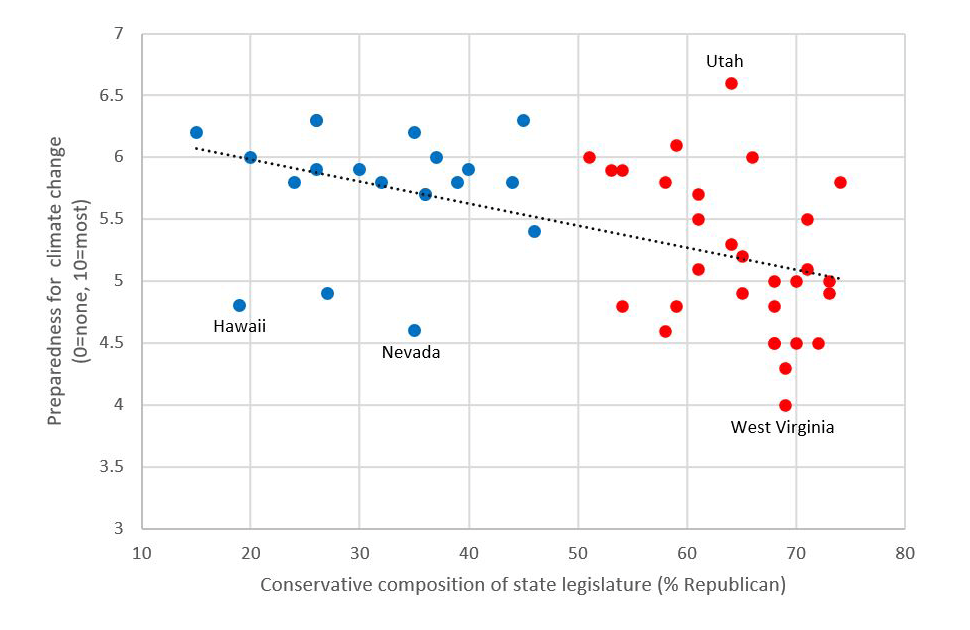
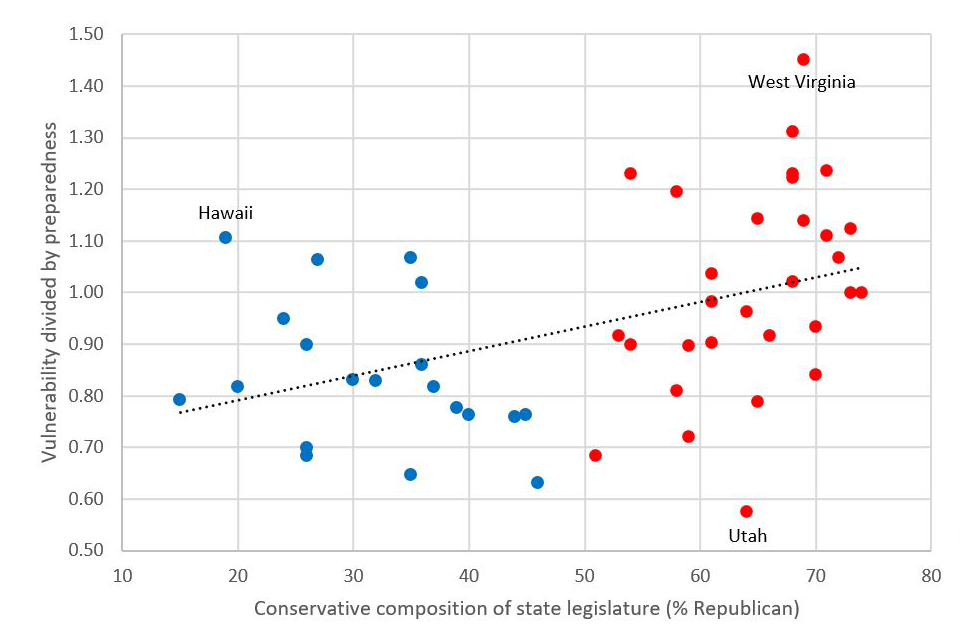 Infant mortality statistics mirror the same pattern. Economics, demographic composition and distribution, health care availability, insurance status, and other factors all play a role in infant mortality and child well-being. But many factors are also connected to decisions that state representatives make. State legislatures are responsible for creating abortion bans that force women into pregnancies, for example, for restricting Medicaid programs, and for creating hostile environments for community-based reproductive care facilities like Planned Parenthood. The full dimensions of infant mortality causes and preventions aren’t well understood, but in the US anyway, the correlation between infant mortality rates and the conservative composition of state legislatures is clear (measuring a solid 0.70). These legislatures can’t be entirely blamed for this issue, but like with climate change realities, they have a bigger problem on their hands than legislatures in liberal states, while at the same time being less inclined, politically speaking, to enact policies that can help bring this problem under control. Will politics or evidence win the day?
Infant mortality statistics mirror the same pattern. Economics, demographic composition and distribution, health care availability, insurance status, and other factors all play a role in infant mortality and child well-being. But many factors are also connected to decisions that state representatives make. State legislatures are responsible for creating abortion bans that force women into pregnancies, for example, for restricting Medicaid programs, and for creating hostile environments for community-based reproductive care facilities like Planned Parenthood. The full dimensions of infant mortality causes and preventions aren’t well understood, but in the US anyway, the correlation between infant mortality rates and the conservative composition of state legislatures is clear (measuring a solid 0.70). These legislatures can’t be entirely blamed for this issue, but like with climate change realities, they have a bigger problem on their hands than legislatures in liberal states, while at the same time being less inclined, politically speaking, to enact policies that can help bring this problem under control. Will politics or evidence win the day?
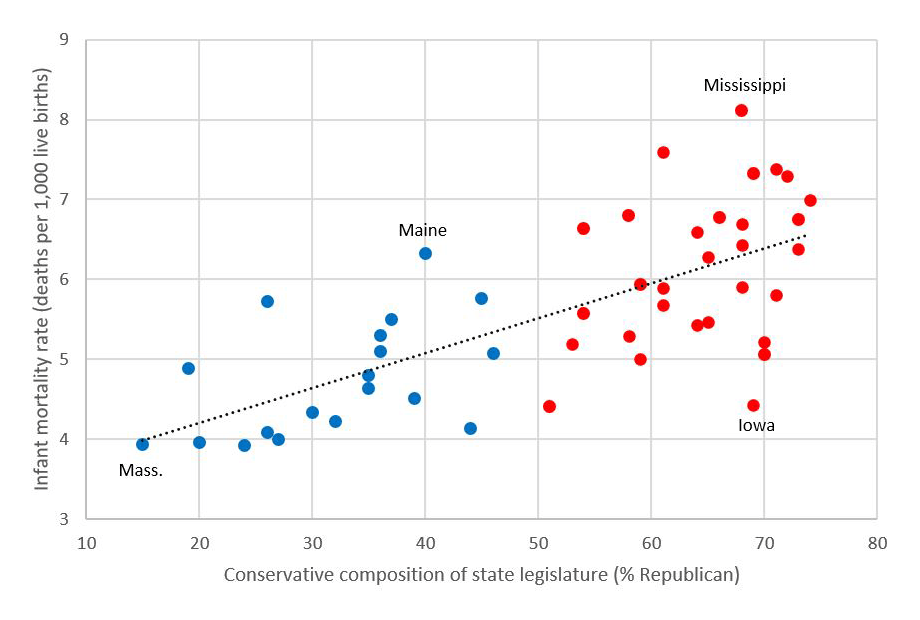
The same is true for firearm deaths. In conservative-run states that have been hostile in recent years toward gun regulations, deaths are much higher per capita than in liberal-run states that are less bashful about discussing policies like background checks and assault weapon bans. Despite the bluster we hear from the NRA about crime-ridden big cities and rural communities that are safer because of guns, the reality is that in states run by conservative legislatures, a higher percentage of people die from firearms than in states run by more liberal legislatures. Here again, correlation doesn’t mean causation, but this correlation (measuring 0.58) does illustrate that all states have a gun problem on their hands. We can hide behind divisive rhetoric, or we can examine the evidence and search together for realistic policy solutions.
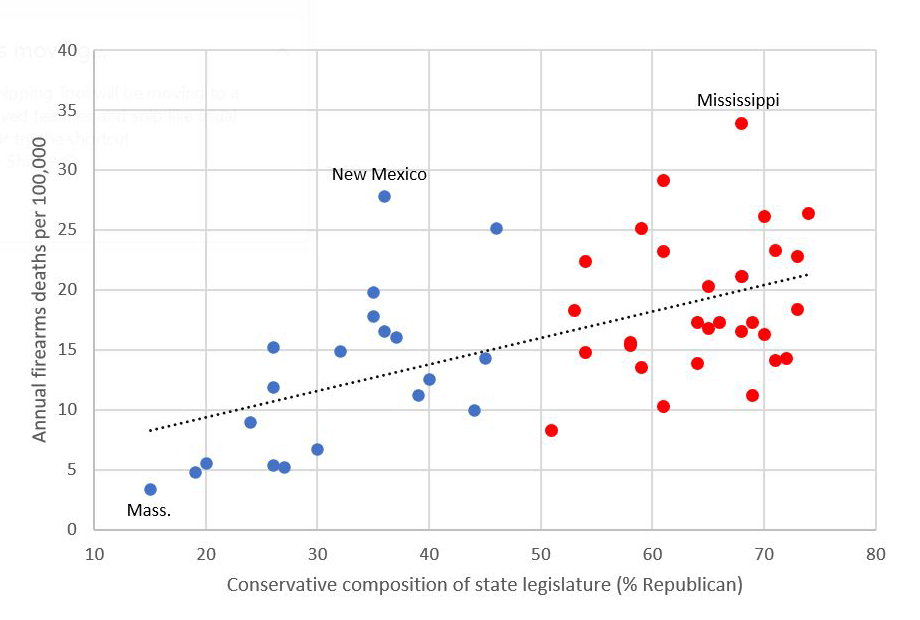
So, in conclusion then, ignoring evidence when creating public policy can be more than just political theater. Ignoring evidence can also have life and death consequences.
Given the anti-conservative examples used in this essay, though, one might also conclude that conservatives are just pro-death. Some might be willing to go there, but correlations alone can’t support this kind of conclusion (for an illustration of why, just look at the Journal of Spurious Correlations at https://www.tylervigen.com/spurious-correlations, where you can note—for example—that there’s a 99% correlation between the divorce rate in Maine and the US per capita consumption of margarine). Also, there are plenty of reasons why states have different opinions on different subjects. Americans are not a monolithic people with uniform concerns, and there are indeed—to resurrect a horribly-applied phrase—good people on both sides.
But the political theater we see today over issues of life and death is new and tragically wrong. Once upon a time in our less polarized world, political parties disagreed at the margins over to how to best serve the people, not whether to serve the people at all. How do we fix this?
Straying even farther from a science focus—but for a good reason (bear with me)—the answer might lie more in politics than policy. What I mean by this is that in a representative democracy—our kind of democracy—we elect politicians to work on our behalf on important issues like climate change. We don’t live in a direct democracy where we vote directly on issues (except through the initiative process, which is used by about half the states). But what happens when our politicians—most notably conservatives but also liberals (both have been drifting away from the center in recent years)—start listening more and more to their base and acting as though we live in a direct democracy? What happens when they start measuring public opinion on climate change before deciding what to do about climate change, instead of being leaders who are well-informed and prepared to make thoughtful decisions on behalf of the people they were elected to serve?
Here’s a story from my past to illustrate this point. I was working for a member of Congress in the late 1980s when one of the hot button issues roiling our country was flag burning. Most Democratic voters at the time were defending the right to burn the American flag in protest, while many Republican voters were lividly opposed, even demanding a constitutional amendment to make flag burning a crime. Voters deluged Congressional offices with phone calls to make their voices heard—this was how it was done in the days before automated phone trees and email. My boss (Republican Congressman Rod Chandler, WA-8) didn’t budge, though. His response to the media? Something along the lines of “I wasn’t elected to hold my finger up and see which way the wind is blowing.”
Congressman Chandler was part the last generation of Republicans who valued principle over party. In the early 1990s, Newt Gingrich introduced the heavy bombast dog-whistle style of political discourse that started pushing the Republican party and voters so far right that moderates like Chandler were no longer welcome (Steve Kornacki has written a great history of this shift; his book, The Red and The Blue, is linked below).
So, back to my question, then, what happens when our elected officials stop being leaders who are well-informed and prepared to make thoughtful decisions on behalf of the people they were elected to serve? What happens when they become mere conduits for public opinion? The answer is that we move farther away from representative democracy, and closer to mob rule. And in mob rule, society’s biases and falsehoods get dangerously amplified, minority rights and equity get trampled, rioters storm government buildings, and crass political calculus replaces sound policy judgement, consequences notwithstanding. In this universe, evidence-free, politically-expedient policies can get adopted that cause great harm.
What’s the solution? It isn’t going to happen anytime soon, but at least part of the solution needs to involve political representatives from all states and parties renewing their resolve to act responsibly when it comes to evaluating evidence and deciding which policies are in the best interests of the people they represent. Maybe this will happen on its own once the Trump fever breaks and parties begin to recalibrate; maybe it will take something more, like a Constitutional crisis. We can talk forever about the need to create better policies, but as long as the political leaders in charge of actually evaluating and enacting these policies aren’t looking at the evidence, then better policy by itself won’t amount to a hill of beans. Reform also needs to happen at the political level.
Data files
Additional reading
Glenn is Executive Director of the Science Communication Institute and Program Director for SCI’s global Open Scholarship Initiative. You can reach him at [email protected].

